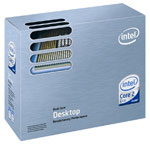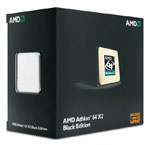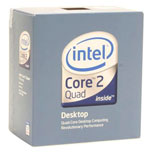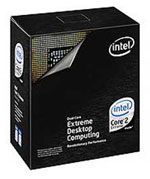Holiday Buyers Guide, Part I: CPUs, GPUs, Mobos, and RAM
by Editorial Staff on November 21, 2007 2:01 PM EST- Posted in
- Guides
A Plethora of Processors
For the past year, AMD simply hasn't been able to compete with Intel's Core 2 Duo on performance alone. AMD tried to recover from the initial Core 2 beating by competing mostly on price, and an aggressive price war followed with several major altercations in late 2006 and 2007. The war may not have done any favors for AMD - or even Intel - but the public has been rather pleased with the slew of cheap and high performance AMD and Intel processors. In the meantime, both companies have been hard at work on the second phase of the battle. Intel has their 45nm process technology primed to up the stakes, and AMD "Barcelona Project" hoped to lead a counterattack and regain lost ground. With the release of AMD's Phenom architecture, many hoped (us included) for a successful return of AMD as a player in the enthusiast/high-end market. Sadly, the first salvo appears to have fallen short.
What remains is a processor landscape that isn't very different from what we've covered in our most recent Buyers' Guides. If you already have an AM2 platform, or if you're looking at something for the budget sector, AMD has some processors that are worth a closer look. For pure performance and/or overclocking, Intel continues to be the leader. Even in the entry-level market, Intel competes quite well with Pentium Dual-Core processors priced well under $100. Less expensive motherboards are the saving grace for AMD's budget-conscious offerings.
Entry-Level
 |
(Brisbane 2.1GHz 2x512K socket AM2 65W)
This is not the cheapest AMD processor, but AMD's X2 4000+ represents fantastic value for those looking for a basic entry-level workstation or home office PC. If you measure heavy usage in terms of how many emails you send in one day rather than your highest 3DMark06 or Crysis timedemo scores, there's no need for anything faster. Even for an entry-level PC, there is always the option to slap in a video card and fire up a game, and the X2 4000+ is no slouch there. Manufactured on the 65nm die process, the Brisbane 4000+ has a lower TDP of 65W than its 90nm predecessors. Running at 2.1GHz, it provides more than enough power for day-to-day activities, while giving users who wish to dabble in overclocking a nice, cheap alternative to an upgrade.
 |
(Allendale 1.6GHz 800FSB 1MB socket LGA775)
The Allendale-based E2140 is the lowest CPU based on Intel's Core 2 Duo architecture, running at 1.6GHz with an FSB of 800MHz and utilizing just 1MB of shared L2 cache. Don't be fooled by the low specs, however, as reports of users attaining a 100% overclock (3.2GHz, 1600FSB) are common, putting this processor firmly into the top spot for those who don't want to spend insane amounts on PCs, but instead want the absolute best bang-for-buck. Who wouldn't, when an E2140 at 3.2GHz is only ~10% slower than the $280 3GHz E6850? People who don't mind spending an extra $10-$15 can upgrade to the E2160 or E2180 (1.8GHz and 2.0GHz respectively) which both come with higher FSB multipliers.
Lower-Midrange/Overclocking
 |
(Allendale 2.2GHz 2M socket LGA775 65W)
The E4500 at stock is faster than the X2 5000+, and is a great processor for those wanting to overclock on a budget. Based on the Allendale core with 2MB of shared L2 cache, this is a minor step up from the 2.0GHz E4400, but with prices often favoring the E4500 these days there's no reason to pick up one of the lower E4x00 models. The added cache relative to the Pentium Dual-Core offerings accounts for about 10% more performance at the same clock speed, and while you can try to increase clock speed, there's no way to add cache without spending a bit more money. With default voltages of 1.185V, the E4xxx series are renowned for running very cool. Users are reporting overclocks of 3.2GHz with ease; just be sure to pair it up with a good motherboard/DDR2 combination if overclocking is the goal.
 |
(Brisbane 2.6GHz 2x512K socket AM2 65W)
For those needing an entirely new PC, we'd go the Intel route on this one. The Core 2 Duo is simply superior to K8; even with Phenom now available, we still recommend Intel's LGA775 over AM2. Penryn processor support (on the appropriate motherboard) only makes the platform more attractive for enthusiasts. That said, we've included the X2 5000+ Black Edition for users with an existing AM2 motherboard and who are looking to upgrade. The Black Edition's hallmark is its unlocked multiplier; effectively making this CPU one of the bargain buys of the year. Why? By simply dialing up the multiplier and keeping the HyperTransport bus at stock, overclocking is an effortless task. Reports of users hitting 3.4GHz are common, and even at stock speed the Black Edition is still competitive to its nearest Intel rival, the E4500. You'll need to purchase an aftermarket CPU heatsink as the Black Edition does not include one, but for anyone remotely interested in overclocking that's pretty much a given already.
Upper-Midrange/High-End
 |
(Kentsfield 2.4GHz 2x4MB socket LGA775)
Arguably the most popular CPU right now, the quad-core Q6600 once again stakes its claim as one of the best bang-for-the-buck options. You can get similarly priced quad-core courtesy of the Phenom 9500 (2.2GHz), but with the Q6600 generally besting even the not-yet-available Phenom 9900 (2.6GHz) we see no reason to go that route, unless you already have an AM2 motherboard and don't mind second-class performance. This is perhaps the final hurrah for the Q6600, as the faster, slimmer, and more overclocking friendly Q9450 is due out in January of next year. That may necessitate the purchase of a Penryn compatible motherboard, however, so if you don't feel like waiting there's still plenty to like with the Q6600.
There's still a shortage of software that benefits from more than two cores; however video encoding, 3D rendering, and certain other tasks will appreciate the extra cores. It may be some time yet before games truly benefit from quad-core, but for $260 you can be ready today for whatever CPU requirements the software of tomorrow brings. If you don't mind overclocking, with appropriate cooling we've also hit over 3.4GHz. Just don't look too closely at the power use of the CPU when you're overclocked that far. Alternately, if you don't want to overclock but you still want improved CPU performance for dual-core applications, consider the E6850. Clocked at 3.0GHz and priced only slightly higher than the Q6600 ($276), for games you will still end up with better performance and less power use by going the dual-core route. (E6550 and E6750 are also reasonable options, naturally.) If you want more than the Q6600, we wouldn't bother with the Q6700. At roughly twice the price, we'd recommend a minor overclock first. Otherwise, you might as well just go all out and grab our extreme recommendation....
Extreme Performance
 |
(Yorkfield 3.0GHz 2x6MB socket LGA775 130W 45nm)
After months of information trickling out regarding Penryn and Intel's move to a 45nm manufacturing process, the major benefits appear to be the increase of L2 cache (2x6MB vs. 2xMB on the Q6xx0) and the reduction in power consumption. SSE4 is also present in Penryn, but application support for the new instructions is relatively limited. Despite its evolutionary nature, Penryn is a worthy successor to the Core 2 line. This is not yet a native quad-core design like AMD's Phenom X4, but Intel's approach of pairing two processor dies onto one package seems to be holding its own. Weighing in with approximately 820 million transistors, the QX9650 comes clocked at 3.0GHz with a system bus frequency of 1333MHz, and is a behemoth of a processor. The 130W TDP is anything but tame, but then you don't expect the heavyweight champion of the CPU world to get by eating only vegetables and fruits.










23 Comments
View All Comments
rudreshsj - Monday, June 16, 2008 - link
the last buyers guide was way back in november the market has substantially changed after that ... pls post a newer updated guide.THX
imperator3733 - Friday, November 30, 2007 - link
On page 2 in the part on the QX9650, you say that the QX9650 has "2x6MB vs. 2xMB on the Q6xx0". It should say "2x4MB", not "2xMB".ac3shi6h - Monday, November 26, 2007 - link
Just upgraded, everything from Newegg.Under $400******
GIGABYTE GA-M57SLI-S4 - $89
AMD Athlon 64 X2 5000+ Black Edition $129
MSI NX8600GTS Diamond Plus GeForce 8600GTS 256MB $149 -$20= $129
Patriot Extreme Performance 2GB DDR2 SDRAM DDR2 800 PDC22G6400LLK 79 - 40= $39
*******
Total = $389,-
Can't beat this value in upgrading from 939 x2-4200+ with a 7800gs
3dmark05
OLD
3dmark = 6932
3d cpu = 6095
New (cpu @ 3ghz 15x multiplier)
3dmark = 12234
Cpu = 7422
Now I probably would have gotten better scores if I spend a little more, but at a 400 dollar budget I don't think I could have gotten any better then this. The only thing I forgot to order was a heatsink.. that bumped me up to 409,-... still though.. I couldn't find any sli capable deal for anything less...
AceY
strikeback03 - Monday, November 26, 2007 - link
We need to build a new computer to interface with our microscope for the lab. Don't need 3D capabilities to speak of, but does need to be able to run a pair of CRTs at 1600x1200 and have Firewire. I checked out the Gigabyte motherboard suggested with the Intel build, but the Gigabyte website says the DVI output cannot be used with an adapter to D-Sub. Can you confirm if this is true, or recommend any other boards that might fit the bill? Or should we just look for a discrete card for either graphics or Firewire?tshen83 - Saturday, November 24, 2007 - link
I agree that the 8800GT is in short supply. However the Radeon HD3870 is also in short supply, if not worse than the 8800GT.Look at the MSRP. AMD advertised 219 as the MSRP, however, newegg and buy.com both raised the price to 269. And you still cannot buy them.
It looks more and more that the HD3870 is here for benchmark purposes, whereas the HD3850 is really what AMD wants to sell. But the Radeon HD3850 is really slow, in my mind, not worth 180 dollars when the 8800GT 512MB is selling for $208:
http://accessories.us.dell.com/sna/products/games/...">http://accessories.us.dell.com/sna/prod...mp;dgc=C...
JarredWalton - Sunday, November 25, 2007 - link
We actually aren't too surprised, but the text was written last week when supply of 3850/3870 cards was better. That's why we state, "While we're on the topic of availability, we must say that we don't know how long AMD will continue to keep up with demand for the Radeon HD 3850/3870. As with the NVIDIA GeForce 8800 GT, many resellers are now backordered and we wouldn't be surprised to see prices begin climbing."JarredWalton - Sunday, November 25, 2007 - link
On a related note, Dell currently has a killer deal on an 8800 GT 512MB card. How long will it last, and how long will it take to get the card if you order right now? Well, those are questions we don't have answers to right now. Still, if you're interested in an 8800 GT card, http://accessories.us.dell.com/sna/products/Games/...">here's the link(I don't know if that's the correct way to link, and the link buttons appear to be broken. Anyway, you should at least be able to see the URL; go to Dell.com and search for 8800GT if you need to.]
FrankM - Friday, November 23, 2007 - link
Am I the only one feeling that there's a bit of a gap between the IGPs and the ~$200 mainstream cards that you called "budget"? I sort of agree that there's not much worth getting between these extremes for current games, but 8600GT @ ~$100 runs OK on medium resolutions and settings, and also offloads HD-media from the CPU.Also, calling ~$200 cards "budget" is a bit weird. Not so long ago, that was mainstream, with budget being sub-$100...
JarredWalton - Friday, November 23, 2007 - link
Well, we did mention them: "There are cheaper graphics cards that provide adequate performance and DirectX 10 support, but the difference in performance between the $100 you might spend on the Radeon HD 2600 XT 256MB/GeForce 8600 GT 256MB and the HD 3850 is substantial. Let's not even get into a discussion of performance requirements for Crysis, Hellgate: London, or Unreal Tournament 3. Needless to say, there are plenty more titles coming out where $100 graphics cards will need to drop down to lower resolutions and medium detail settings in order to provide adequate performance."Chubbbs - Thursday, November 22, 2007 - link
"the G35 is next week"Yes, finally!! This is the platform I've been patiently waiting for. Not all enthusiasts are gamers. Some of us want a superior workstation without the cost, power consumption, acoustics, and binary blobs associated with discrete graphics. All we ask is for is modest composite and decode acceleration and a digital output (two would be nice). But that doesn't mean we don't want a premium ATX board with 8 SATAs, solid caps, and effective chipset radiators.
There *is* a retail market for a $150-200 motherboard with integrated graphics. In fact, if we're going to pay $200 or more for a motherboard, shouldn't we expect it to include onboard graphics? It's not like it precludes adding discrete graphics, and it offers a much lower power mode for those rare moments when you're not gaming. I look forward to AT's in-depth analysis of Intel's long-overdue foray into integrated graphics for the midrange performance market.